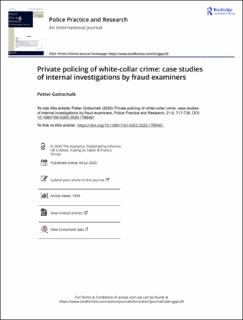| dc.contributor.author | Gottschalk, Petter | |
| dc.date.accessioned | 2021-06-29T11:43:26Z | |
| dc.date.available | 2021-06-29T11:43:26Z | |
| dc.date.created | 2020-06-30T08:59:46Z | |
| dc.date.issued | 2020 | |
| dc.identifier.citation | Police Practice and Research,2020, 21:6, 717-738, | en_US |
| dc.identifier.issn | 1561-4263 | |
| dc.identifier.uri | https://hdl.handle.net/11250/2762337 | |
| dc.description.abstract | Private policing of white-collar crime has been a controversial issue for quite some time. Fraud examiners from global auditing firms and local law firms conduct internal investigations, resulting in reports of investigations that are the clients’ confidential property. This article presents four disclosed reports of investigations to illustrate the theory of convenience for white-collar crime and to determine the examination maturity in private policing. The suggested maturity model with five levels determines whether the investigation as chaotic or messy, or whether the investigation contributed to disclosure or clarification. The most mature level is investment, where the benefits of the examination exceed the costs of the examination. Many fraud examiners have a long way to go before them deserve the label of professional investigators or examiners. Future research may help professionalize the business of private policing of economic crime. The four reports of investigations are from Moldova, the Netherlands, Sweden, and Switzerland. | en_US |
| dc.language.iso | eng | en_US |
| dc.publisher | Taylor and Francis | en_US |
| dc.rights | Navngivelse 4.0 Internasjonal | * |
| dc.rights.uri | http://creativecommons.org/licenses/by/4.0/deed.no | * |
| dc.subject | Private policing | en_US |
| dc.subject | White-collar crime | en_US |
| dc.subject | Fraud examination | en_US |
| dc.subject | Internal investigation | en_US |
| dc.subject | Case study | en_US |
| dc.title | Private Policing of White-Collar Crime: Case Studies of Internal Investigatons by Fraud Examiners | en_US |
| dc.type | Journal article | en_US |
| dc.type | Peer reviewed | en_US |
| dc.description.version | publishedVersion | en_US |
| dc.source.pagenumber | 717-738 | en_US |
| dc.source.volume | 21 | en_US |
| dc.source.journal | Police Practice & Research | en_US |
| dc.source.issue | 6 | en_US |
| dc.identifier.doi | 10.1080/15614263.2020.1789461 | |
| dc.identifier.cristin | 1817706 | |
| cristin.ispublished | true | |
| cristin.fulltext | postprint | |
| cristin.qualitycode | 1 | |

